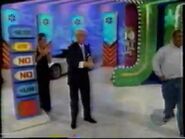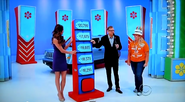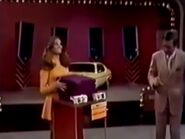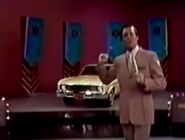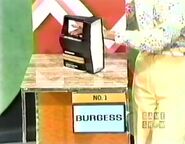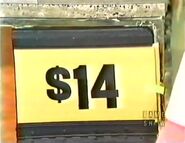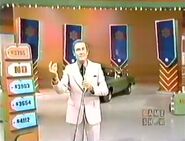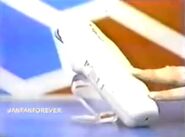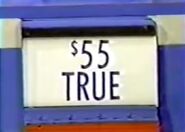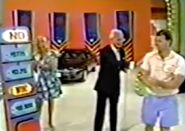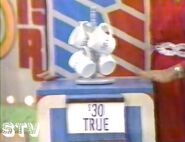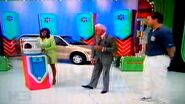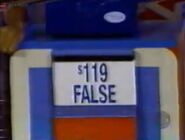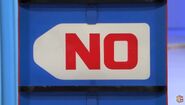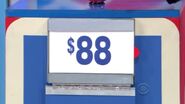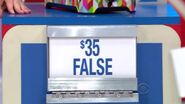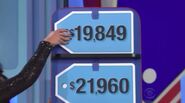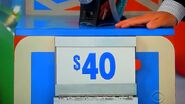The name came from the fact that there are five price tags, one of which is the actual price of a car. The contestant plays a game of True or False with small prizes to win those prizes and up to four choices of the five price tags.
Gameplay
- The contestant is shown four small prizes, one at a time, and must decide whether the price displayed on each prize is true or false. If the contestant is right, the small prize is won and he/she earns a choice in the second part of the game. If the contestant is wrong, the small prize is lost and he/she does not earn a choice. If the contestant earns no choices whatsoever, the game is automatically over. Therefore, the number of prizes earned in the first half determines how many choices of the five price tags they may make.
- After all four prizes are played, and assuming the contestant has earned at least one choice, the contestant begins selecting prices from the five tags. One at a time, the contestant chooses a price he/she believes is correct; if the contestant is right, he/she wins the car. If not, he/she continues to choose until all earned choices have been exhausted.
Since there are five prices and only four small prizes, earning all four choices does not guarantee a win, although the odds of losing are very slim at that point. Obviously, the more chances the contestant earns, the more chances he/she has of winning the car.
History
- After the game premiered on September 26, 1972 (#0042D), it was lost. It was first won on October 2, 1972 (#0051D).
- Early on in the game's existence, instead of a buzzer, a car horn was used for a wrong pick from one of the five price tags.
- On February 2, 1982 (#4382D), the small prize labels have changed from yellow with black letters to white with blue letters. Exactly 2 years later or on February 2, 1984 (#5184D), the 3rd and current small prize podiums have been introduced, along with their original, red-and-blue prize backdrops.
- Originally, a red price tag was used for the correct price; on January 19, 1988 (#6722D), it was changed to a "WIN!" graphic, initially using a blue outer graphic before switching to red on November 17, 1988 (#7034D), the same color as "WIN!" on a yellow background. On March 12, 2010 (#5075K), the bottom part of the prop is changed from white to red. On January 21, 2014 (#6582K), the prices in the tags now have a shadowy font and the tags now have a white border.
- The game was played once on the primetime version of the show. It was on May 3, 2003 (#010SP) and it was won.
- On April 2, 2015 (#7074K), with three choices earned, after contestant Andrea Ellis guessed the top price on her first pick wrong, Manuela Arbeláez mistakenly revealed the next one in line before she made another decision, forcing Andrea to win the car.
- On May 11, 2016, the game made an appearance on Let's Make a Deal as part of a mash-up between both shows (The May 11, 2016 (#7533K) TPIR episode featured Gold Rush from Let's Make a Deal). If the contestant chose the price the model accidentally revealed, they would've won $20,000.
Trivia
- While the show was still a half hour long, 5 Price Tags and Most Expensive shared the same set props which are the four big blue vertical price tag lights with red supports used to light up and indicate how many chances the contestant has to win the car. In fact, three of them had shelves to hold the price cards. When Most Expensive finally got its own props as well as its title, the shelves were removed and neon chevron lights were added to the backs of them.
- So far, this is the only game (other than One Wrong Price) to not have its name anywhere on the props.
- Like Gas Money, an unwritten rule is that the prices of all prizes end in 0 or 5, except in the rare case that 0 or 5 is not one of the provided choices.
- The most number of times this game was played in any season was 80.
- The small prize portion of this game is trickier than it seems. Most contestants are inclined to respond "False", to the given prices of the small prizes, when the majority of them are actually "True". As a result, more of the small prizes are guessed incorrectly, and most contestants only win one or two choices of the five potential car prices.
Foreign versions
- On Mexico's Atínale Al Precio, called "Cinco Precios" (Five Prices), the game was not played for a car.
- On the Bob Warman version in the UK, a free pick was given at the start of the game, and grocery items were used instead of small prizes.
Pictures
5 Price Tags from October 3, 1973 (#0573D, aired out of order on November 28) and featured on Disc 2 of the DVD set. Notice the thin price tag posts with shelves.
The ultra cool win tag, from 1988. The letters are in purple. The spark is yellow and the background is blue.
This is what the Win tag looks like nowadays. The letters and the background are red instead of blue.
From November 14, 1972 (#0112D)
Five Price Tags for an Opel 2-Door Sedan (August 28, 1975, #1564D)
From November 17, 1988 (#7034D)
Five Price Tags for a Mitsubishi Eclipse (September 27, 1991, #8115D)
Five Price Tags for a GMC Safari (February 24, 1993, #8713D)
Mark's Five Price Tags Wipeout (April 10, 1997, #0334K)
Five Price Tags for a Chevrolet Corvette (May 3, 2003, #010SP)
Byard's Five Price Tags Wipeout (April 27, 2009, #4731K)
Juan Plays Five Price Tags with Sharon Osborne (January 23, 2013, #6193K, aired out of order on February 20)
Alexander's Excellent 4-Pick Playing (June 18, 2014, #6793K)
Five Price Tags Blooper Win (April 2, 2015, #7074K)
From October 4, 2017 (#8033K)
Latosha's Excellent Mini Cooper Win (April 1, 2019, #8691K, aired out of order on March 15, originally rescheduled to air on March 25)
Artwork
Videos
A blooper win (April 2, 2015, #7074K)








